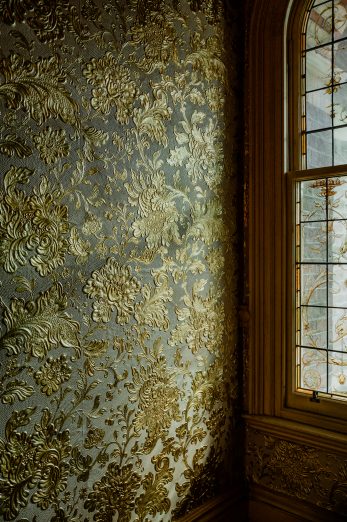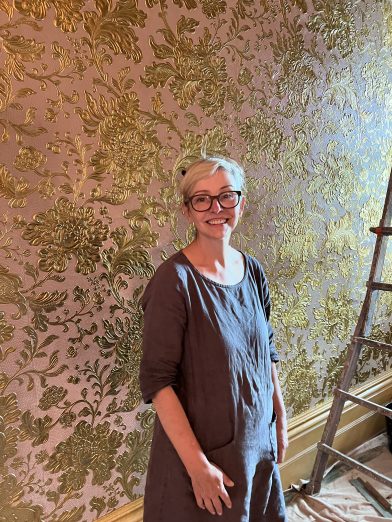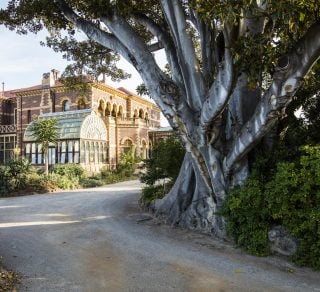It was 7 years ago that the Tokyo based Kinkarakami Institute was commissioned to create approximately 10 square metres of gold embossed wallpaper, recreating the pattern and texture of the hall filler paper at Rippon Lea. The newly crafted and installed wallpaper represents the culmination of almost 10 years of work. A visit to Rippon Lea today confirms that this quest was well worth the effort.
To be successful, the project needed to operate within a broad community of practice, ranging from Trust staff and volunteers researching the history of Rippon Lea to the laboratories of conservators affiliated with the University of Melbourne and Japanese artisans, scholars and architectural historians. By tracing a brief history of the paper’s popularity and manufacture many connections continue to be found. In many ways, the project reflected the historical cultural exchange of Japanese leather wallcoverings.
In the late 1880s, Frederick Sargood began renovating his mansion in Elsternwick. He had reached a position of public prominence and Rippon Lea became an important place to showcase his and his family’s contributions to community life. The house and grounds were often used for fundraising, fetes and the hosting of dignitaries, amongst other public events and purposes. The estate became a showpiece, that included new technologies, plant collections, gardening innovations and fashionable interiors. Sargood was the Executive Vice-President of the 1888 –89 Melbourne Centennial International Exhibition that was held in the Melbourne Exhibition Building. One question we may only ever have a partial answer to is did he purchase the Japanese leather wallpaper to decorate his halls from Rottmann Strome & Co. As we shall soon learn, Rottmann Strome play an important role in our story. The company exported wallpapers from Japan and exhibited at this particular exhibition.
In the West, leather paper not only decorated the walls of the very rich, but also more modest dwellings. It was often recommended by self-help guides for use as an insert into the panels of interior and cabinetry doors, in this way introducing fashionable design into many homes. Australian references include the use of Japanese leather in first class railway carriages and pub walls in Queensland. The product simulated tooled and embossed leather and was used wherever this decorative effect was desired.
Kinkarakawakami (gilt foreign leather paper) was the Japanese name for gold embossed leather paper. Kinkarakami (gilt foreign paper) is the contemporary version of this paper. Embossed leather kinkarakawa (gilt foreign leather) was introduced to Japan by Dutch traders in the seventeenth century and the fashion for tobacco pouches and other personal effects grew amongst the Samuri class. This led to a widespread interest in this luxury product. Japanese craftspeople began to experiment, recreating the leather effect in paper. This also allowed the items to be used in temples as it was vegetarian. It wasn’t until the Meiji Restoration period (1868 – 1912) that the technique was perfected and exported. It was popular as a wall covering in Western style houses in Japan, but as an exported product it led to the establishment of a prosperous industry that was overseen by the Japanese government. One company that had a lucrative contract to export these products was Rottmann Strome and Co. a well-known British company who were contractually aligned with the Japanese Government from 1884 to 1890.
In the 1890s, the exuberant scroll foliate design of the Rippon Lea paper was gold embossed with a hand-painted pink tinted background. This original scheme offset the sage green polychrome paintwork, Belgian rouge marble fireplace and black granite pillars. The effect would have been striking. In the late 1930s, the last private owner of Rippon Lea, Louisa Jones, re-decorated her home but retained many of the textures and patterns of the late nineteenth century. The hall papers were updated with a scumbled surface that accentuated the paper’s relief and covered the lost and tarnished metallic sheen.
Architectural historians had long speculated that the hall papers were made in Japan, as the embossed pattern appeared to reference those produced during the Meiji period (1868 – 1912), but no conclusive evidence was found in pattern books and other printed documentation. One method of determining Japanese manufacture was the materiality of the paper, asking the question could Kozo fibres (from the Mulberry plant) be found if a materials analysis was performed by conservators? Kozo fibres would only be present if the papers were of Japanese origin. The restoration project began with a grant submission to the Australia Japan Foundation for funds to explore this possibility. Could the process determine whether the wallpaper was of Japanese manufacture?
The University of Melbourne Grimwade Centre for Cultural Materials Conservation performed this analysis. An unpainted fragment was found by the Trust behind an over-mantle mirror during restoration works in the 1990s, it was very discoloured. The conservators cleaned the fragment and exposed the original paint scheme, it was a delight to finally see the pale pink tint revealed from the sooty grime. The conservators compared the Rippon Lea paper to an example already identified as Japanese. This sample came from the Trust property – Labassa. It too was redecorated in the 1890s and is an example of late Victorian design. Labassa’s hall-papers feature a very popular pattern exported by Rottmann Strome and Co. and it has been identified in pattern books and interiors in Australia and the U.S.A. According to the Kinkarakami Institute, this particular pattern was created for the Emperor of Japan’s palace and features fertility symbols. The empress found the pattern too ornate and rejected it, but it proved incredibly popular in the West.
Conservators performed a series of tests that included in situ reflected light microscopy, X-ray fluorescence spectroscopy, fibre analysis with a sample stained and viewed under a microscope as well a cross section examined under a stereo-microscope. The report concluded that fibres consistent with Kozo were present but also cereal grains, tin and zinc that matched the Labassa sample. It provided enough evidence to confirm that Rippon Lea’s paper was indeed Japanese. This was a breakthrough moment.
Once the materiality was established – we were ready for the next step – which was to connect with craftspeople with a high level of skill to recreate the paper. At the time this task was fraught with difficulty. All the proposed techniques known to us were inadequate – resulting in shallow embossing and loss of detail. Also, they were lacking in cultural sensitivity and respect for the original craft, as was a deep connection to practice and a contribution to the ongoing significance of Rippon Lea. The Trust turned to the Australia Japan Foundation for help. A Japanese curator and scholar – Dr Chiaki Ajioka – was on the organisation’s board. It was through her generous assistance and introduction to the artisans of The Kinkarakami Institute that the project could continue.
The Institute is a small team of two expert craftspeople – Takashi Ueda, the master of the technique, and Kazuhiro Ikeda his apprentice. The team hand-carve, emboss, varnish and paint using traditional techniques and materials. No part of the process is mechanised and the wallpaper is made primarily from plant materials. As mentioned, Kozo, or Mulberry plant pulp, and cereal grains are used to create the paper and the pattern is carved onto the cylindrical trunk of a specially selected cherry tree. The paper is also often ‘fixed’ using the juice of persimmons to make the backing waterproof and mould resistant. Mr Ueda revived the lost techniques in the 1980s. Along with archival and material cultural research, he also experimented with materials. The result is Kinkarakami. The Institute have completed many restoration projects in Japan and are now looking to the rest of the world. The Trust’s commission is the first of its kind outside of Japan.
The Trust hosted the Institute when they visited Melbourne to participate in the 2016 ICOMOS Conference and offer a masterclass. An exhibition of their work was also on display at Labassa. It was critical for the craftspeople to visit Rippon Lea and they took measurements and images of the pattern to assist with their carving. Mr Ueda was overcome with the scale of the Trust’s collection of Japanese paper at both Rippon Lea and Labassa, claiming that it could be the largest collection of Kinkarakawakami outside of Japan.
After establishing the provenance of the paper, the next phase was the carving of the cherry wood roll, which functions as the mould into which the damp paper is pressed. With funding support from the Copland Foundation, the Trust was able to proceed with this next fundamental step. Additional help was then generously sought and given by the Trust Foundation and private donors, enabling the completion of this unique project. The paper was gilded with a thin layer of tin. The damp paper then pressed – tin side down – onto the roll and beaten with special boar bristle brushes that agitated the paper fibres together to create a long continuous drop of wallpaper. The tin was varnished to transform it into a rich golden colour and lastly the background was painted.
The final installation has been the result of many years of patience and persistence. The approach has made emphatic the work of many hands – both historical and contemporary – whose presence can be seen and felt in the building and collection. The project emphasised the importance of craft histories and the complex relationships of late nineteenth century design and cultural appropriations. Rippon Lea’s interiors are brimming with cultural references and samplings. It operates within complex cultural entanglements, exploring how things are made and how they came to be in place. The Trust’s objective is to make visible to visitors the many hands at work around them – both past and present – local and international.
At Rippon Lea, the new wallpaper is installed alongside the old – creating a new relationship, a new object in a new setting. The installation celebrates an adapted technique, closely related to its traditions, but transformed through experimentation into a contemporary object in and of itself. Visitors can appreciate the look and effect of the late nineteenth century decoration. Today, we have a corner of glowing spectacular floral and scroll folate pattern reflecting the changing light as it streams through the windows.
Come and see the wallpaper at Rippon Lea Estate on a guided tour (on the hour until 2pm). The Estate is open from 10am to 4pm daily.
















